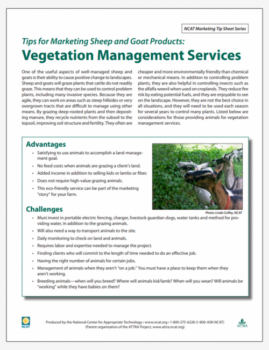Tips for Marketing Sheep and Goat Products: Vegetation Management Services
NCAT Marketing Tipsheet Series
By Margo Hale and Linda Coffey, NCAT Agriculture Specialists
One of the useful aspects of well-managed sheep and goats is their ability to cause positive change to landscapes. Sheep and goats will graze plants that cattle do not readily graze. This means that they can be used to control problem plants, including many invasive species. Because they are agile, they can work on areas such as steep hillsides or very overgrown tracts that are difficult to manage using other means. By grazing deep-rooted plants and then depositing manure, they recycle nutrients from the subsoil to the topsoil, improving soil structure and fertility. They often are cheaper and more environmentally friendly than chemical or mechanical means. In addition to controlling problem plants, they are also helpful in controlling insects such as the alfalfa weevil when used on croplands. They reduce fire risk by eating potential fuels, and they are enjoyable to see on the landscape. However, they are not the best choice in all situations, and they will need to be used each season for several years to control many plants. Listed below are considerations for those providing animals for vegetation management services.
Advantages
Satisfying to use animals to accomplish a land-management goal.
- No feed costs when animals are grazing a client’s land.
- Added income in addition to selling kids or lambs or fiber.
- Does not require high-value grazing animals.
- This eco-friendly service can be part of the marketing “story” for your farm.
Challenges
- Must invest in portable electric fencing, charger, livestock guardian dogs, water tanks and method for providing water, in addition to the grazing animals.
- Will also need a way to transport animals to the site.
- Daily monitoring to check on land and animals.
- Requires labor and expertise needed to manage the project.
- Finding clients who will commit to the length of time needed to do an effective job.
- Having the right number of animals for certain jobs.
- Management of animals when they aren’t “on a job.” You must have a place to keep them when they aren’t working.
- Breeding animals—when will you breed? Where will animals kid/lamb? When will you wean? Will animals be “working” while they have babies on them?
Tips
- Learn all you can about managing vegetation with sheep and goats and develop a budget to see if a project will be economically feasible before you commit.
- Start small and locally with pilot projects to work out kinks to reduce your risk.
- Have clear goals—what does the landowner want the land to look like? Look at the property together and agree on an initial assessment that includes a description of the vegetation, take photos, and have the goal in writing.
- List yourself as a service provider through Livestock for Landscapes, sheepandgoat.com, or the local Extension office. Join sheep or goat associations in your area and be sure to be listed on any relevant websites as a provider.
- Don’t take on more than you can reasonably do, or promise more than is feasible. Your good reputation is essential for success.
- Once you are comfortable with your work, engage the press and raise public awareness to build your business. See the Livestock for Landscapes CD for tips.
- Build a website and create flyers to promote your eco-friendly enterprise. Take before and after photos and use to recruit new clients.
Resources
- ATTRA – National Sustainable Agriculture Information Service
- Targeted Grazing Manual
Learn more about using targeted grazing and how to write a contract that will help both you and the livestock owner. See especially chapters 16 and 17, written by experienced providers. - Livestock for Landscapes
See the Goats! For Firesafe Homes in Wildland Areas CD, which includes information on writing contracts, marketing the service, tips for success, a Goat Calculator to help you figure out the approximate costs, and a
sample business plan template. - Langston University
This website has a lot of great information, especially pertinent to Oklahoma and other centrally-located states. Begin with the Meat Goat Production Handbook and read the Vegetation Management chapter by Dr. Steve Hart. There are also reports about many of Langston’s projects on controlling vegetation and reclaiming abandoned land. See the 2004 Proceedings of the 19th Annual Goat Field Day for several articles. - American Sheep Institute (ASI)
See the “Sheep in the Environment” section, as well as the “Targeted Grazing” page. - Maryland Small Ruminant Page
Go to the “Forages,” then “Weeds,” and then “Targeted Grazing” pages. There are webinars and a wealth of other information here. - Utah State University Cooperative Extension BEHAVE program
Learn about animal behavior and how to use it to improve results in managing land. See especially the DVD/CD set Saving Money and Improving Landscapes: The Economics of Using Animal Behavior, which includes videos, fact sheets, examples, scientific publications, worksheets, and tables.
This publication is produced by the National Center for Appropriate Technology through the ATTRA Sustainable Agriculture program, under a cooperative agreement with USDA Rural Development. The development of this material was supported through USDA/NIFA/OASDFR.
Tips for Marketing Sheep and Goat Products: Vegetation Management
Services
© 2012 National Center for Appropriate Technology
By Margo Hale and Linda Coffey, NCAT
Production: Robyn Metzger
IP403 Slot 397 Version 072712


